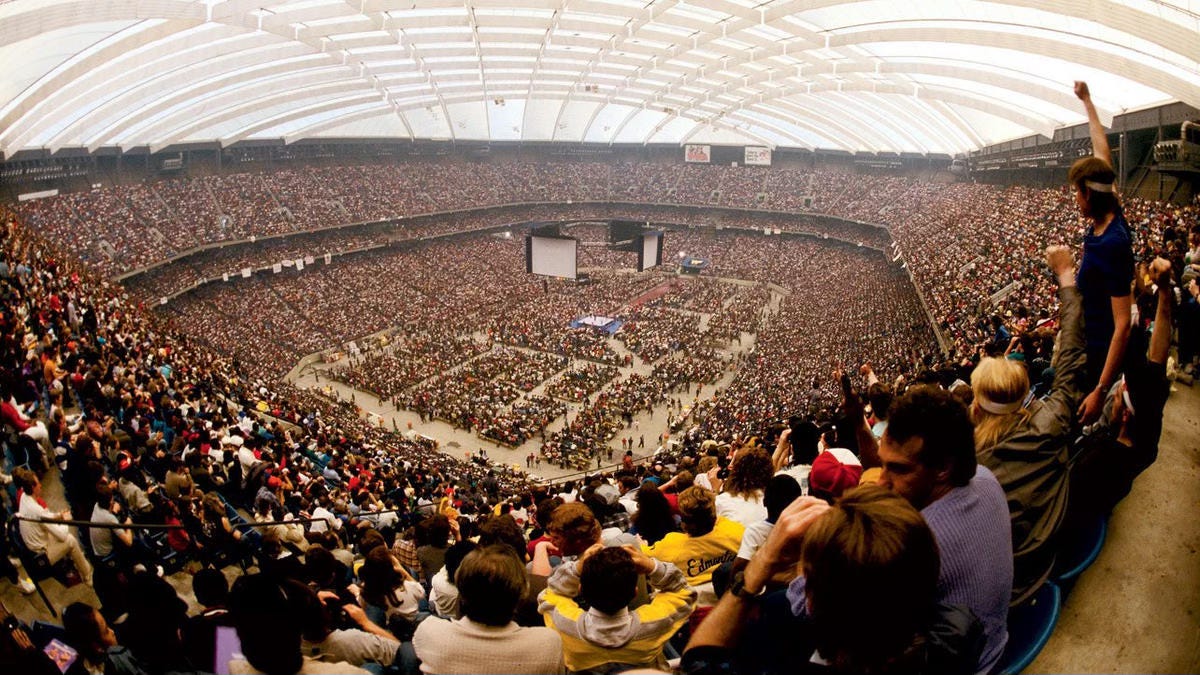There's a new wrinkle to the WrestleMania III attendance drama!
And it's from a decently authoritative source!

We’ve been here before: Almost six years ago, I wrote a Deadspin article where I tried to get to the bottom of the arguments about the true attendance of WrestleMania III at the Silverdome in Pontiac, Michigan. I had long felt that though it was obvious that 93,173 was a made-up number from WWE, the turnstile count of roughly 78,500 that Wrestling Observer Newsletter editor Dave Meltzer got from local promoter Zane Bresloff and later WWE proper didn’t feel like it fit, either. It went against everything else in the public record about the Silverdome, and we knew that the show was sold out, with both the Lansing State Journal and the Detroit Free Press saying as much three days out. Public record requests to get any more detailed information about the Silverdome went nowhere. All we really learned was that, going into the show, basically everyone was saying that the crowd would be about 88,000 fans, roughly what you’d expect given the football capacity of just over 80,000 and WrestleMania not having an elaborate stage/entrance set yet.
Two-and-a-half years later, I came to find out that “everyone” included a WWE press release six days out, with WWE never following it up by putting out another release to announce “93,173.” In writing that blog post, I also came to realize that if you left out the Silverdome’s “club” and “suite” levels, the 78,500 figure suddenly made sense. The idea that the official paperwork could be missing those was rooting in reality — building settlements don’t always include suites — would explain everything.
We also know, thanks to a Detroit Free Press article that ran two days before the show, that there were at least 3,130 people in the building who were doing their jobs at the show: 2,500 concession stand workers plus 350 stadium personnel plus 100 reporters in the press box plus in excess of 180 WWF personnel based on the number of hotel rooms secured by the company. I had also learned, from both then-WWE photographer Tom Buchanan and a fan in the since-hidden Deadspin comments, that, to avoid unrest among fans who showed up without tickets thinking they could buy them at the door, WWE let in a large amount of fans for free as standing room only. Suddenly, the idea that there were well over 90,000 human beings in the building was starting to make some sense, as well. (And for good measure, I later figured out that pay-per-view broadcast of the show was bought by 30% more homes than previously believed.)
That takes us to the latest find. Cory Gibson, the ever-dogged wrestling historian and archivist, recently went on a research trip to grab scans of WWF-centric articles in the trade publication Amusement Business that weren’t in news databases. The abstracts were, which made them easy to find, but not the actual articles. Those microfilm finds include Amusement Business’s coverage of, yes, WrestleMania III:
World Wrestling Federation's Wrestlemania III, with Hulk Hogan defeating Andre The Giant in the title bout, drew 93,173 persons to the Silverdome on March 29, making it the world's largest indoor stadium event.
The previous indoor crowd record was held by the Rolling Stones, who drew 87,500 in 1981 to their Louisiana Superdome performance in New Orleans.
The Wrestlemania III crowd also broke the building's attendance record, set in 1982 by Super Bowl XVI which drew 82,000- 83,000, according to Silverdome Director Mike Abington. "Our next largest crowd will be Sept. 19. when Pope John Paul II will be here," he said.
Skipping ahead past some whoppers from WWE about PPV buys and closed-circuit TV ticket sales, we hear from the Silverdome’s Mike Abington again:
Abington said the attendance figure of 93,173 "included everyone in the building" Tickets sold totaled 88,100, with tickets priced at $100, $30, $20, $15 and $9.
There it is: The building explicitly claiming “tickets sold” — the lack of a paid/comp breakdown suggests that may actually be tickets distributed — was 88,100, right in the range of what he had been claiming a sellout would be before the show. Adding in 3,130 working at the show without tickets and that’s 91,240, 1,933 short of 93,173 before we try to factor in the fans let in as standing room admissions without tickets.
Even if we take this information at face value, though, there are some lingering questions. That building settlements don’t always include suites and similar seating is a simple enough explanation for the lower number on the official paperwork, but that doesn’t explain experienced live event promoter Zane Bresloff not knowing this when he first sent the records to Meltzer. Or why he would downplay his biggest accomplishment as a promoter if he had any inkling that the smaller number wasn’t entirely legitimate. (Unless Bresloff working for WCW at the time is reason enough for you.)
Regardless, though, we now have a fairly authoritative source — the actual venue management in the leading sports and live event business trade publication at the time — giving a number that tracks with what all of the information not in the building settlement says about what a wrestling sellout in that building would look like. But this probably won’t settle anything, regardless.


